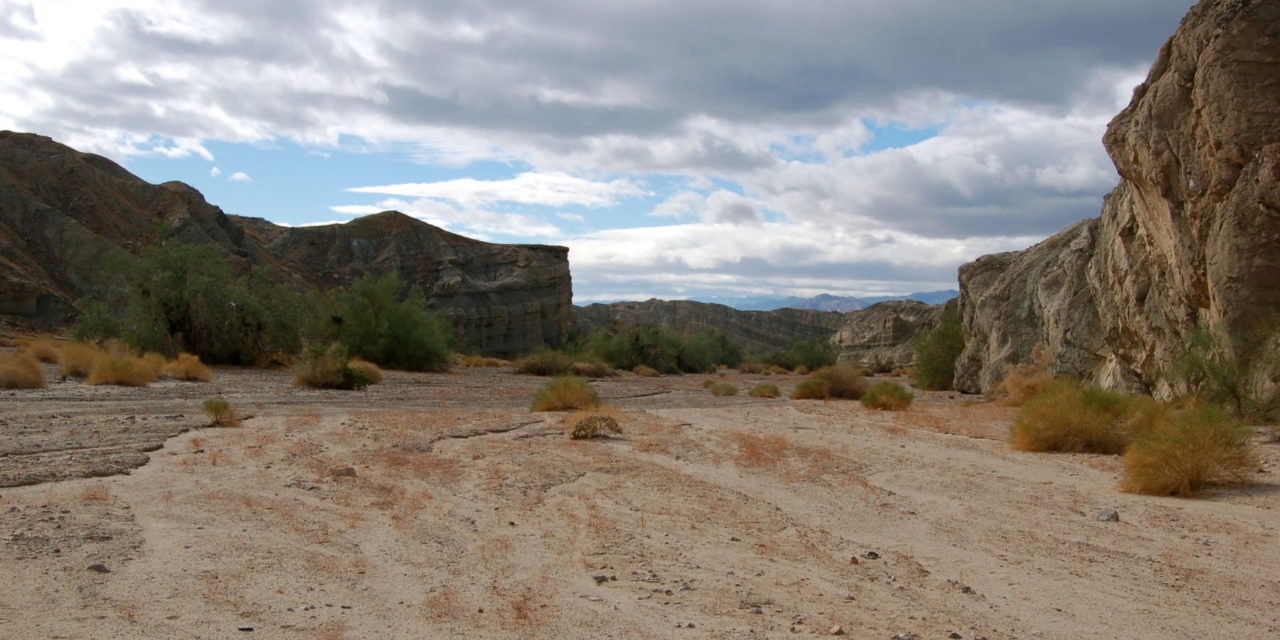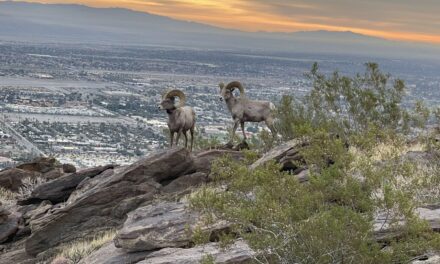Geographically, the Mecca Hills mark the Coachella Valley’s eastern edge.
Day hikers can climb through a small cave and enjoy fantastical and colorful rock formations in the Mecca Hills Wilderness.
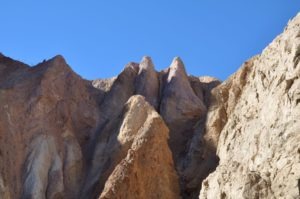
The trail cuts through badlands-like rock formations of mudstone and sandstone.
The 3.65-mile round trip Rainbow Rocks Trail consists of a section of the Hidden Springs Trail. Because of the desert heat, the trail is best done in October through May. Never enter the canyon if rain is forecast or for a couple of days after rain has fallen.
To reach the trailhead, take Calif. Hwy. 111 south to Mecca. Turn left/northeast onto Fourth Street and at the roundabout go right/southeast onto Hammond Road. The street naturally curves east and becomes 66th Avenue. East of town at Garfield Avenue, the street becomes Box Canyon Road and curves northeast. The road then crosses the Coachella Canal and enters a broad sandy wash and finally Box Canyon.
While the road is paved, you’ll need to drive slower in Box Canyon. Turns can be tight, and a thin layer of sand often covers part of the asphalt.
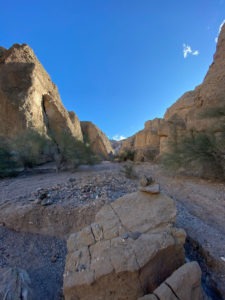
A grotto and the Rainbow Rocks sit at the end of a side canyon.
A single wood post lets you know you’ve reached the parking area – which is just a sandy wash – for the trail to Sheep Hole Oasis. It’s roughly five miles from the canal. The trailhead for Hidden Springs Canyon is on the road’s east side and marked by rocks placed in the ground across the canyon’s mouth.
Follow the canyon east. In about 350 feet, the trail climbs atop a ridge and curls south. You’ve entered a region of barren hillsides banded in earth tones, reminiscent of South Dakota’s Badlands.
In about a quarter mile, a small clump of fan palms appears in the canyon below. This is Sheep Hole Oasis, an important watering ground for bighorn sheep.
The trail descends to the oasis and then follows the canyon south. As the trail’s sandy surface suggests, water cuts out the canyons in these hills. The sandstone easily erodes when flashfloods rush through and with the wind constantly striking the canyon walls.
In about a half mile, watch for a trail cutting through a side canyon to the east. Take this up over a small ridge and then down into Spring Canyon.
Upon entering the wide wash, go east and follow it as it turns northeast. Upon reaching another split, about a third of a mile up the wash, go right/northeast. The canyon here narrows.
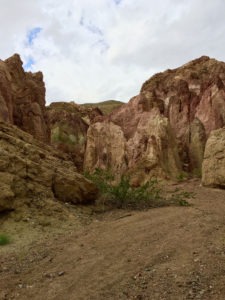
Rock shearing abounds in the canyon leading to Rainbow Rocks.
Geographically, the Mecca Hills mark the Coachella Valley’s eastern edge. They formed as the Pacific Plate to the west of the San Andreas Fault slid past and under the North American plate. This lifted and folded the North American plate here. Water and wind then carved the sandstone into a series of clefts and gorges.
In another third of a mile is a small slot canyon heading north. This heads to Hidden Springs. Instead continue right/east up the wash.
Shortly thereafter in about an eighth of a mile, a second canyon heads north leading to The Grotto. Continue straight-right/east. You’ve now left the Hidden Springs Trail.
As the wash curves south, it passes some fascinating examples of rock shearing, or warped rocks. Shearing here occurs as the Pacific and North American tectonic plates move laterally against one another. The pressure of that movement is so intense that it reshapes the buried rocks.
You’ll reach a grotto in a little more than a third of a mile. A grotto is a small cave that usually floods during rainfalls. Erosion in this steep mud and slot canyon created the cave-like formation. This particular cave often is referred to as “Grotto #2” on maps.
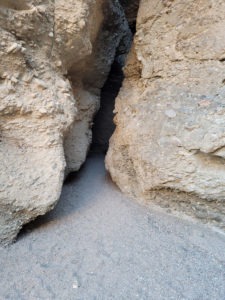
A small opening takes hikers into a grotto.
The grotto has a narrow opening. You’ll need a flashlight to see while crawling around inside.
The cave ends at a rock wall. If you’re able, climb the rock wall up. The reward for your effort is the Rainbow Rocks, a colorful array of boulders and dirt.
The varying colors offer a mini-lesson in the Mecca Hills’ geology.
If you see gray rocks that are extremely hard, they’re the Coachella Valley’s bedrock. This gneiss formed between 1.8 billion and 1.65 billion years ago, long before there was plant or animal life on Earth.
Mixed with the gneiss are layers of much younger rock. Among them are brown volcanic tuff – hardened ash – and sediments of Dos Palmas Rhyolite that settled here between 23 million to 5.3 million years ago.
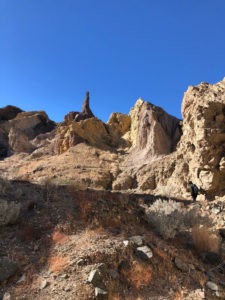
On the other side of the grotto are the colorful Rainbow Rocks.
Much of the Mecca Hills consists of reddish sandstone and conglomerate – pebbles cemented in layers of finer grain sands – of the Mecca Formation. This formed about 5.3 million to 2.58 million years ago when flash flooding washed away sediment from higher land east of the Coachella Valley and deposited it on alluvial fans that already were here.
Usually above the red rock are the tan, buff and gray layers of sandstone of the Canebrake Formation. This was set down between 2.6 million years to 11,700 years ago when water flowing out of higher ground to east deposited sediment here.
If you notice white, crystal-like rock snaking through a canyon wall, you’ve come across an aplite dike. It’s mainly quartz and light-colored feldspar that formed about 10 miles below the surface. There, heat and pressure allowed the rocks to melt and flow upward into the surrounding rocks, which since have been uplifted and exposed.
After taking in the sights, head back into the grotto and retrace your steps back to the parking lot.
Most of the trail is exposed to the sun, so you’ll definitely need to don sunhat, sunglasses and sunscreen. Bring plenty of water. Because of the cave and boulders to it, you may want to carry gloves as well.
Image Sources
- 02-The-trail-cuts-through-badlands-like-rock-formations-of-mudstone-and-sandstone.: Rob Bignell
- 03-A-grotto-and-the-Rainbow-Rocks-sit-at-the-end-of-a-side-canyon.: Rob Bignell
- 04-Rock-shearing-abounds-in-the-canyon-leading-to-Rainbow-Rocks.: Rob Bignell
- 05-A-small-opening-takes-hikers-into-a-grotto.: Rob Bignell
- 06-On-the-other-side-of-the-grotto-are-the-colorful-Rainbow-Rocks.: Rob Bignell
- Most of the trail runs through the sand washes of box and slot canyons.: Rob Bignell

